Greg Moore’s 3.2-litre Porsche 356 Speedster replica
Replicas based on non-factory chassis have always been controversial, but given the iconic 356 Speedster is out of reach for many of us, the next best thing is a facsimile of the real deal. Despite owning a genuine 356, Greg Moore has created his own very special take on the Speedster concept...
SPEEDSTER STIR-UP 356 AMERICA ROADSTER
Words Johnny Tipler
Photography Dan Sherwood
Greg Moore’s 3.2-litre Porsche 356 Speedster replica
Speedster! It’s such an evocative word, colonised by Porsche back in late 1954, when it introduced the sporting version of the 356, beloved of amateur racers, including Steve McQueen. Given the values of vintage Porsches, especially rarities like this, it’s no surprise a number of enterprising manufacturers have come up with replicas. This is what we have here, based on a 356 Speedster copy produced by Speedster Clinic. More on this in a minute. First, let’s see what all the fuss was about.

Travelling right back in time, we see the Speedster epithet was first coined in 1913 by the Detroit Cyclecar Company, then by Studebaker in the 1920s and Auburn in 1935. Perhaps it’s surprising, given the simplicity of the etymology, more manufacturers haven’t bagged the name for themselves? After all, the more generic ‘roadster’ label is way less evocative of high performance. More recently, Vauxhall’s excellent, mid-engined, Lotus Elise-based VX220 (launched in July 2000) was branded as the Opel Speedster for sale in Germany, but that’s yer lot.
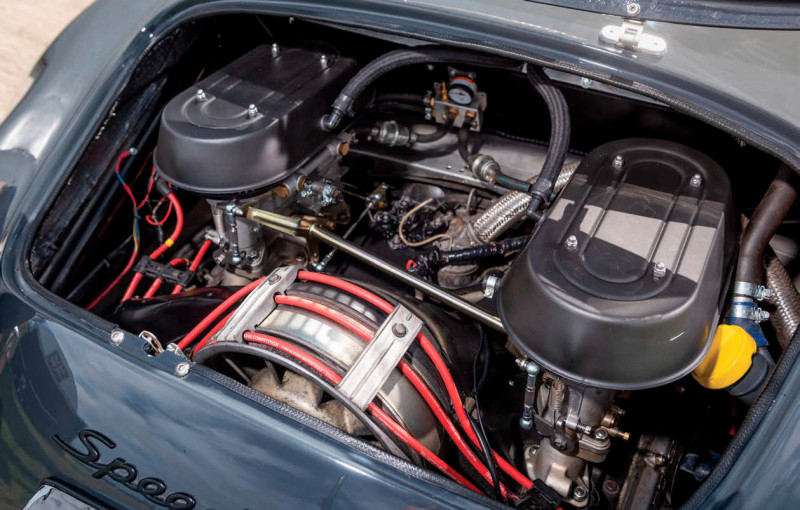
Speedsters of the Porsche persuasion ooze style, grace and charm, suggesting greater alacrity than the standard car, and they say a lot more about the owner’s character than does the regular design. There’s an aerodynamic purpose too, as well as a stylistic marker — the Speedster windscreen header rail is slanted more acutely and several wind-cheating inches lower than normal. It’s designed to be completely removable for competition use, when a flyscreen (and goggles) might be substituted. You don’t want bugs or stones in your face! The 356 Speedster did have a hood, albeit oldfashioned apparatus consisting of a short pull-up canopy and rudimentary frame, rather like that of a pram. It’s no bad thing, then, that our subject car has a thoroughly practical and easily detachable hard-top.
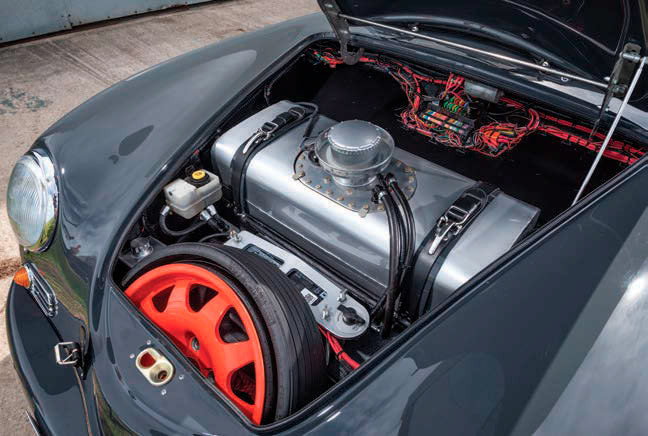
Porsche produced five incarnations of the Speedster. One based on the 356, like the replica we have here, one on the Carrera 3.2 (featured earlier in this issue of Classic Porsche), another one the 964, a follow-up based on the 997 platform and, in advance of the 2019 model year, 1,498 examples of the 991 Speedster.
The original Speedster was the idea of New York based Porsche concessionaire Max Hoffmann, who persuaded Porsche to try a raw, no-frills version of the 356 with minimal roof and priced under three thousand dollars. The car was a hit with Californian hipsters, of whom James Dean was one, Roy Orbison another. Earlier, in 1951, Hoffman had also encouraged Ferry Porsche to produce a short run of the Type 540 America Roadster (also documented earlier in this magazine), based on a handful of curvaceous aluminium shells made by Heuer- Glaser coachworks. Despite costing $4,600, these droptops sold at a loss and broke the bodybuilder. Hoffman’s full order book was nevertheless an incentive for Porsche to provide him with the sportscar he advocated, and out came the spartan Speedster, built by Reutter.
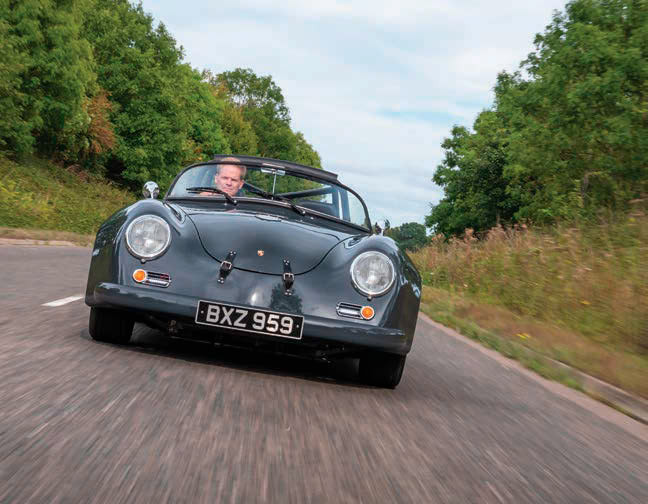
The 356 Speedster was in production from 1954 to 1958, enjoying a fair amount of race and rally class success in contemporary events, including the Mille Miglia. Despite low production numbers, it was a significant front-line model, showcasing Porsche’s competition endeavours and aspirations. With this in mind, it’s surprising there was no direct successor in the classic ‘long-bonnet’ 911 range.
The 356 Pre-A Speedster 1500 (1,234 units made) was replaced in October 1955 by the 356 A (T1) version, available with either 60bhp 1600 N ‘Normal’ or 75bhp 1600 ‘Super’ engine. The 356 A (T2) Speedster appeared in September 1957 (2,910 units made, including T1 and T2), replaced by the less austere 356 Convertible D (from coachbuilder Drauz at Heilbronn) in August 1958. By way of identification, the T2 Normal engine’s fan housing was painted black and the Super’s was painted silver. A new Type 716 gearbox was installed in late 1958. A further 167 Carrera GS and GT Speedsters ran with the four-cam Fuhrmann engine, capable of 120mph — a truly awesome prospect if you’d driven the regular 1600 Speedster at an apparently death-defying 80mph. Otherwise, evolving detailing over the Speedster’s life was fairly minimal, involving steering wheel, door handles, striker plates, bumpers and exhaust outlets.
A long time gone, the Speedster was absent from the 911 line-up from 1959 until the Carrera 3.2 Speedster was shown at the Frankfurt Motor Show in 1987. The concept was far more akin to the old 356 formula: a simple, lightweight, open-top 911, intended to be built on the upcoming 964. Presented as 911 sales were declining in the US, the new Speedster was based on the end-of-term 3.2 chassis in a bid to revive flagging sales.
CUT THE COMEDY
Between 1988 and 1989, 2,103 Turbo-bodied SuperSport and 171 narrow-bodied examples of the Carrera 3.2 were released, but although a Club Sport version was made with no windscreen at all, theirs was never a competition role, more a stylistic statement. The 964 Speedster maintained the tradition — 945 examples left the factory in the 1993 model year, relatively late in the 964’s lineage. They were rear-drive Carrera 2s rather than Carrera 4 chassis, and all but fifteen were narrow-bodied. Whereas the 356 Speedster did experience some evolution, neither the 3.2 nor the 964 Speedsters received any upgrading during their brief production lifetimes.

A singleton 993 Speedster was created by Porsche Exclusive for Butzi Porsche in 1995. Comedian and classic Porsche collector, Jerry Seinfeld, had a 993 Targa thus converted in 1998. As for water-cooled Speedsters, in 2010, the 997 version was unveiled. Just 356 examples were manufactured. Twenty-two came to the UK, in deference to the 356 Speedster. Standard colour is Pure Blue. Carrara White was optional. The 997 Speedster’s screen is seventy-seven millimetres shallower than that of the 911 997 Cabriolet.
Accordingly, it has a bespoke roof and double-bubble tonneau cover. As we outlined earlier in this magazine, the model features the 408bhp Power Kit version of the second-gen 997’s 3.8-litre flat-six, mated to the seven-speed PDK transmission (manually controlled by paddle shifters). This is a very highly spec’d Porsche with all modern paraphernalia, which means it’s not really relevant to our story. I’m just saying it’s out there and masquerading as a Speedster. Porsche may have made only 356 units, but it is about as far away from the original Speedster concept as you can possibly get. Not so the Speedster Clinic replica we are about to play with on a former RAF base in Suffolk. The car’s steroidal rotund wings and wheel arches are not merely an aesthetic expression of Greg Moore’s liking for RS extravagances — as well as cladding genuine BBS splitrim wheels, they also conceal suspension componentry from a pair of unlikely sources. Up front, the car employs a 924 S steering rack, and at the rear, 944 S2 lower trailing arms, plus Brembo calipers and 944 Turbo discs. These makes Greg’s car much wider than a 356 Speedster ever was. “The 924 steering rack and the bottom arm it connects to are made of steel, whereas the 944 part is aluminium. I could weld the steel to the bottom suspension bar, which is like the crossmember for the 924 welded to the front of the suspension, allowing me to use 924 rack-and-pinion. I knew I had the geometry right because it was a Porsche set-up. One of the things I was blown away with was how parts work together from different Porsches of different ages. I’ve installed a 1976 915 gearbox, a 1985 Carrera 3.2 engine, 944 arms and tubes, 944 Turbo brakes, and it all just fits together.”
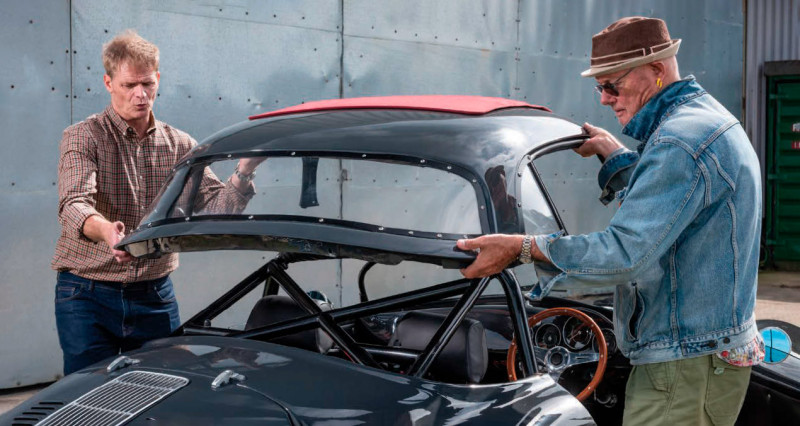
BBS split-rims are usually gold centred with a shiny diamond-cut outer rim, but Greg had the sixteen-inchers pictured here powder-coated in a shade of grey ordinarily reserved for RS-badged Audis. They’re shod with 205/55 and 225/50 Toyo T1R tyres — a tall wall for get a nicer ride. “The calibration of the speedometer has to be right to pass the Individual Vehicle Approval (IVA) test, which meant limiting tyre size to the diameter of what it would have been on a 911. The car passed first time, which I was quite pleased about — this is a common fail.”
The work wasn’t quite a solo mission. “I was helped by Nick Clarke, who did a lot of the welding, and Neil Chillystone, who helped with the mechanicals. Neil owns Woolleys Service Station at Hingham, and between the three of us, we built the car and got it through the IVA test, which is quite a beast to get through.” Examiners are particularly strict on the position of lights. “The rears were fifteen millimetres too far in,” Greg sighs. “I had to cut the fibreglass and move them in, but the tester let me do it on-site in order to avoid a re-test.”
Kenilworth-based Speedster Clinic was established more than twenty years ago by Gary Blundall, making Volkswagen Beetle-derived chassis and fibreglass body kits to produce bespoke hand-built 356 Speedster, 356 Coupe, Pre-A Coupe and 550 Spyder replicas. In Greg’s case, he needed something extra to obtain the shape of those lardy wings. He was inspired by a limited-edition 356 Speedster, the wide-bodied 356 California, which he’d glimpsed as a child. “Gary helped me out with the wider wings,” he reveals. “The wide arches came from Mexico and they were just basic fibreglass panels.” They were originally made by Vancouver-based Intermeccanica, itself a vestige of the 1950s and 1960s Italian car and speed equipment builder, currently making 356 replicas. Greg cites Aaron and Luke at LA Custom Coatings at Dereham, Norfolk, for achieving excellent panel fit and the splendid paint job.
As far as the engine was concerned, a humble 1.6- litre flat-four wasn’t going to cut the mustard. Besides, when you’re assembling a replica, the sky’s the limit. Greg originally had a 2.7-litre flat-six lined up, but couldn’t get it running. He took the troublesome boxer to Mike Bainbridge in Cumbria, whereupon he discovered the unit was irreparably damaged. Instead, Greg bought a 3.2-litre from a scrapped 911. It cost six grand, but had covered only 70,000 miles and was running nicely. Mike installed the engine and mated it to the rebuilt 915 transmission.
BALANCE OF POWER
The 3.2-litre lump runs 46mm PMO carburettors, Stuttgart Classica stainless steel manifolds., Magnecor ignition leads and a 123ignition programmable distributor. The petrol tank mounted in the front luggage bay is a Fuelsafe product from the USA, bought from a seller on the DDK website. Ahead of the tank, where you’d expect it to be, is a spacesaver spare wheel.
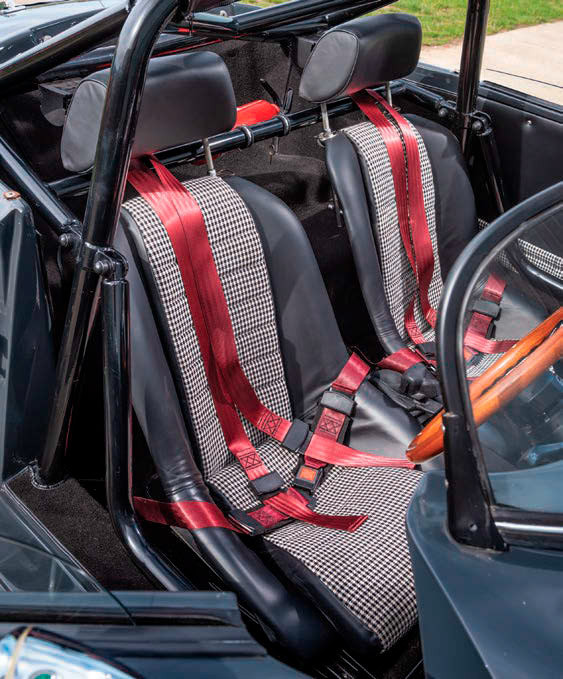
The surprises come thick and fast. “We did a lot of work on the chassis, which is basically a Volkswagen floorpan, but we removed all the VW suspension and installed Porsche gear.” The floorpan is surmounted by what amounts to a semi-triangulated spaceframe, carrying an American Wire 21 wiring loom kit and Cable Tec cables. “An integral roll cage runs all the way from the rear engine mounts via the GAZ Gold coilover mounting points through to the front, resulting in a kind of triangulated chassis that’s all TIG-welded, including the rollover hoops. Long story short, it’s about as strong and as torsionally rigid as it can be — you can lift up a corner of this car and the neighbouring corner will rise with it!” There’s a catch here. “Obviously, a flat-six makes a car tail-heavy and we were working with a very short wheelbase, which is why I added weight to the front.”
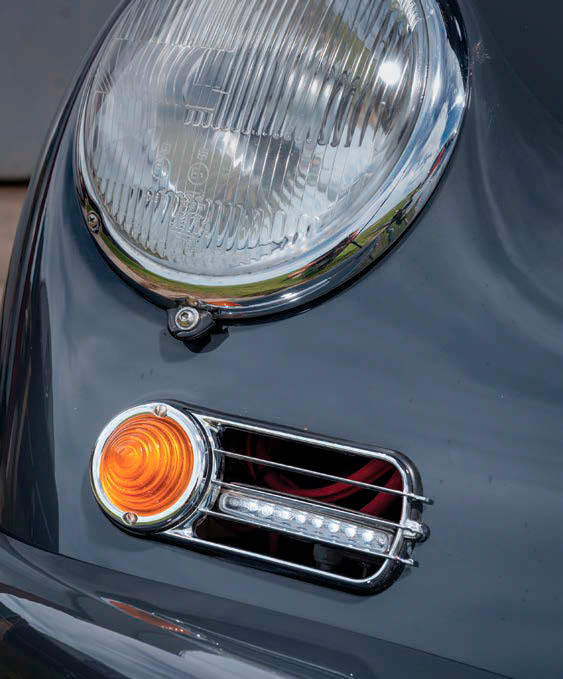
There was no messing about. “There’s a steel crossmember all the way across the front, which we filled with fifty kilograms of lead to keep the nose down. It works — I had the car on axle stands and the ratio was about 55/45 front to rear weight distribution. Of course, it means the car now weighs more than you might expect, tipping scales at 1,100kg. But then, there’s a 3.2-litre 911 engine in the back instead of a 356 flat-four. That’s 220kg versus something like sixty for a four-cylinder powerplant.” The 911 engine delivers twice the power, too. Moreover, this Speedster replica is lighter than a Carrera 2.7, which registers close to 1,440kg.
Greg, who just happens to have a genuine 1959 356 coupé tucked away (acquired for £800 when life was cheap), hadn’t until now driven his Speedster with the hard-top removed. Not because he’s in any way averse to trad Speedster motoring, but because lifting the lid over the roll cage is a two-man job. The panel is easy enough to detach, just not to remove. The hard-top is surmounted by a sunroof, hence the red textile patch, custom-made from a roof-curve template by Legacy Products in the USA. “I wanted the car to be drivable in the UK in all seasons, which you can’t really do in a Speedster because, in the rain, which we have a lot of in this country, a Speedster leaks! In contrast, with this car, you can drive along with the sunroof open, allowing you get the feel of a soft-top, but from a lid refusing to allow moisture ingress.”
The exterior period look is enhanced by the doormounted racing mirrors, sourced from Sierra Madre, a company famous for supplying reproduction 356 parts. The front side grilles housing the indicators also house LED driving lights, which come on with engine start-up. “You have to have the side indicators for the IVA test, though obviously they were never there originally, so I pulled them down as low as I could go.
They look a bit like the Reutter badge at first sight,” Greg smiles. The louvres and replica Speedster air vent grille surmounting the engine lid, complete with 3.2 badge, are convincingly done, and the lid hinges are actually anodised Mini door hinges. Attention to detail is meticulous — the leather securing straps, made by an equestrian saddler at Hot Rod Leather, have flaps underneath them to prevent the buckle chipping the paint. As for the number plate, it’s probably worth a small fortune to a 959 owner.
And so to the very smart cockpit. The seat bases are aluminium and were made in Italy by an apprentice craftsman at the Carrozzeria Ferrari Franco workshop. “They were his rite of passage from apprentice to technician,” Greg tells us. “They’re powdercoated chrome by Aerocoat, affording the backs a wonderful mirrored effect. They’re a work of art, though I had to install the headrests to comply with IVA regulations.” The seats are upholstered in an attractive houndstooth check, with cut-down 911 RS padding, applied by Garry Hall at Porsche interior trimming outfit, Classic FX. The three-point harnesses, meanwhile, are aviation belts out of an aeroplane, as worn by cabin crew during landing and take-off. Steering is by way of a quick-release 350mm wood-rim Sparco wheel, the handbrake is from a Beetle and the gear lever is a 964 item paired with a standard 915 shift pattern. The door cards and carpeting were crafted by Lotus trimming specialist, Steve Fulcher at Hethersett. The pedal box is out of a 964, with Wilwood hydraulic clutch and a custom accelerator pedal. The instrument binnacle is familiar enough — 1985 vintage — though the dials and gauges have been embellished in green and black with chrome bezels by Reap Automotive, based in north London. Unusually, they’re paired with a 997 light switch. “Because the body was so modified,” Greg continues, “I’ve tried to keep everything else original, at least from the Porsche parts catalogue.”
The opportunity to drive anything on an aerodrome perimeter runway is generally welcome. Between takeoffs, landings, and the odd chopper-hovering, I take to the wheel. You certainly know you’ve climbed into something a bit special, even if this isn’t a genuine 356 Speedster. The cockpit is a wee bit tight, and I know what Greg means when he says he wants to lower the driving seat. Everything inside the car is exquisite, though. I like the drilled window winders, the door pulls, the handles, and all the dials being recognisably Porsche. The 964 pedal box is set to the left in true right-hand drive 911 fashion, requiring the legs to veer awkwardly leftwards. The clutch is supremely sharp, causing me to stall the engine several times before getting underway. Even on the smooth main runway, this is a hard ride. I certainly know I’m travelling on firm suspension.
SUPER SPRINT
Acceleration is decently quick, as you might expect from a snarling 3.2-litre engine powering a two-seater. I run out of straight surprisingly quickly before swaying into the first of the huge flat bends delineating the airstrip. The steering feels nicely weighted, although it is heavy, as though I’m helming a boat. The brakes also take some getting used to, requiring me to stand on them to achieve a rallentando — not too much feedback there. The shift is as good as a 915 gets. In action, this car comes across very much as the period piece it purports to be. A harsh critic might accuse me of saying it looks better than it goes, but that would be missing the point: when you’re creating a replica and not manufacturing a toolroom copy, you can experiment and include pragmatically anything to hand that takes your fancy.
Over the years there have been other producers of 356 Speedster replicas, most of them based on Volkswagen platforms. Chesil, Beck, Pilgrim, Special Edition, JPS Motorsports, Apal, Vintage Speedsters, Silverstone Mexico and Intermeccanica, which I mentioned earlier, are the best known, while Iconic Autobody clads a 987, following its now discontinued work turning 986 Boxsters into Speedsters. There are companies dedicated to providing parts for 356 Speedster and 550 Spyder replicas, too. Fibersteel is one of the most prominent. And should you wish to engage in shock tactics at Classics at the Castle, the Sebring Speedster is an EV 356 replica. That’d certainly set the cat amongst the pigeons.
In any case, Greg has gone several stages further than any of the Speedster replica producers, including Speedster Clinic, on whose product his car is based. He’s pretty happy with the final outcome, although he has pondered whether or not he should have created a mid-engined Speedster using an off-the-shelf Patrick Motorsports powertrain kit. As it is, he’s created a oneoff, his personal take on the Cal-Look 356, distinctive yet discrete, an intriguing melange of Porsche componentry and very nicely executed.
The end result is a tad enigmatic, since it is faster, rortier, though weightier of feel than a 356 rag-top, not to mention less nifty because of its wide boots. Would Jimmy Dean have approved? A replica is simply the disguise of an actor imitating the real thing. This is not so much an imitation as a one-off. It’s a novelty item, a curiosity and, actually, a rather special treat.
Above Greg is happy with the outcome of this build, though wonders whether a mid-mounted engine might have been a good move in the interests of improving the car’s handling Below It’s a Speedster, Jim, but not as we know it.
DISTINCTIVE YET DISCRETE, AN INTRIGUING MELANGE OF PORSCHE COMPONENTRY AND VERY NICELY EXECUTED
Above LA Custom Coatings in Dereham was tasked with the paintwork, which covers Intermeccanica wide arches expertly grafted onto the Speedster Clinic body.
Above and below Greg is the owner of a genuine 1959 356 coupe, but wanted to go to town on a 356 replica built to his own specification, hence the Speedster Clinic body he’s brought up to its current state.
AS FAR AS THE ENGINE WAS CONCERNED, A HUMBLE 1.6-LITRE FLAT-FOUR WASN’T GOING TO CUT THE MUSTARD
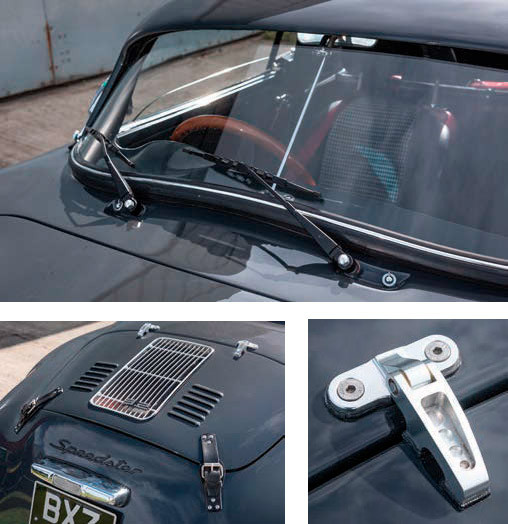
Above Carrera 3.2 engine makes use of PMO carbs and manifolds from air-cooled Porsche accessories supplier, Stuttgart Classica. Above and below Wide body and fat wheels hide steering and suspension components borrowed from Porsche’s transaxle family of cars. Above Roof removal is a twoman job, hence the sunroof added for flying solo Below 3.2-litre boxer requires a high-capacity fuel tank, this one imported from Fuelsafe


